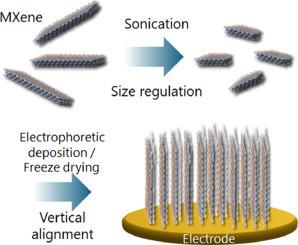用于快速锂离子存储的垂直排列MXene电极的尺寸依赖性电化学性能
IF 5.6
3区 材料科学
Q1 ELECTROCHEMISTRY
引用次数: 0
摘要
MXenes是电池和伪电容器极具吸引力的材料,因为它们比碳或氧化物具有更高的电子导电性,并且可以进行表面限制的氧化还原反应。然而,二维纳米片的重新堆积可能会限制离子在MXene电极中的传输,并导致缓慢的充放电。为了了解和控制Ti3C2Tx MXene的二维质量输运性质,我们制作了不同扩散长度和纳米片排列(垂直和水平)的电极。电极是通过电泳沉积和冷冻干燥相结合的脱层尺寸调节的MXenes(95至~ 600 nm的横向尺寸)。研究了它们在非水电解质中的电化学锂化/去锂化行为。垂直排列厚度为300 μm的Ti3C2Tx MXene薄膜比水平堆叠厚度为10 μm的MXene薄膜具有更快的Li+存储速度。由于Li+扩散路径较短,小尺寸薄片电极具有较高的放电容量和高速率的容量保持率。垂直排列的MXene电极具有较高的电化学性能和快速充放电性能。本文章由计算机程序翻译,如有差异,请以英文原文为准。


Size-dependent electrochemical properties of vertically aligned MXene electrodes for fast Li-ion storage
MXenes are attractive electrode materials for batteries and pseudocapacitors because they have higher electronic conductivity than carbons or oxides and can exhibit surface-confined redox reactions. However, restacking of 2D nanosheets may limit the ionic transport in MXene electrodes and lead to sluggish charge/discharge. To understand and control the 2D mass transport properties of Ti3C2Tx MXene, we fabricated electrodes with different diffusion lengths and nanosheet alignments (vertical and horizontal). The electrodes were made by combining electrophoretic deposition and freeze-drying of delaminated size-regulated MXenes (95 to ∼600 nm lateral size). Their electrochemical lithiation/de-lithiation behavior was studied in a non-aqueous electrolyte. Vertically-aligned Ti3C2Tx MXene film with a thickness of 300 μm provided faster Li+ storage than horizontally-stacked MXene film with a thickness of 10 μm. Electrodes made of small-size flakes exhibited higher discharge capacity and capacity retention at high rates due to a shorter Li+ diffusion path. The vertically aligned MXene electrodes show high electrochemical performance and fast charge/discharge.
求助全文
通过发布文献求助,成功后即可免费获取论文全文。
去求助
来源期刊

Electrochimica Acta
工程技术-电化学
CiteScore
11.30
自引率
6.10%
发文量
1634
审稿时长
41 days
期刊介绍:
Electrochimica Acta is an international journal. It is intended for the publication of both original work and reviews in the field of electrochemistry. Electrochemistry should be interpreted to mean any of the research fields covered by the Divisions of the International Society of Electrochemistry listed below, as well as emerging scientific domains covered by ISE New Topics Committee.
 求助内容:
求助内容: 应助结果提醒方式:
应助结果提醒方式:


